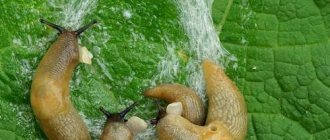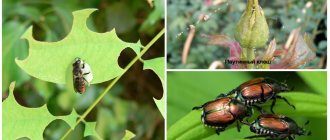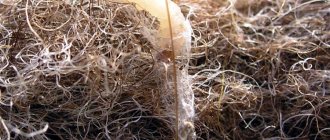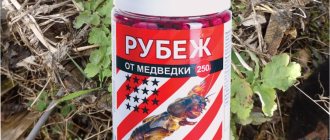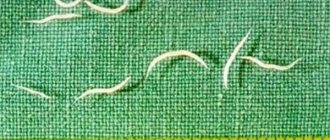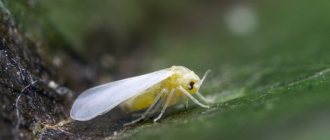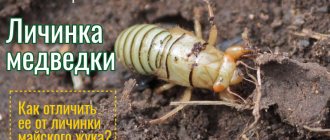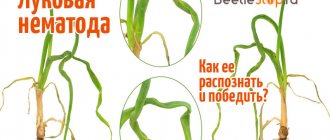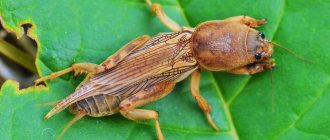Cucumbers are quite capricious to grow; they require optimal conditions in terms of parameters such as temperature, humidity, and the amount of microelements in the soil. In addition, they are susceptible to various diseases. The article outlines the main diseases of cucumbers in a greenhouse and their treatment, you will find out why the leaves turn pale and dry, the ovary disappears, how to understand that cucumbers have been attacked by aphids and spider mites, why cucumbers do not set. More often, gardeners encounter the following pests: Greenhouse whitefly - a small but voracious insect that can suck juice from leaves in a short time. As a result of its vital activity, a sooty fungus is formed and the plants die. Aphids are sucking pests that appear on cucumbers in July-August. It develops quickly, depletes plants, sucking out juices and spreading viral diseases. Aphid colonies can be found on the undersides of leaves.
Pests of cucumbers - description with photos
Table 1
| Name | Description |
Spider mite | This pest is ubiquitous, but gives greater preference to enclosed spaces. The appearance of a mite is indicated by the cobwebs woven by the insect on the growth shoots. A reddish-green small pest hiding on the underside of the leaf blade During a season, a female is capable of laying more than one and a half hundred eggs, giving birth to several generations. 2 weeks after laying, the larvae are able to completely dehydrate the plant by sucking out its juices The insect does not have a protective layer on its body, which makes it easier to combat it with chemicals |
melon aphid | The name of the insect is conditional - the pest is omnivorous. The glutton barely reaches 2 mm and has a green, oblong-rounded body. You can find a colony of aphids on the underside of the leaf, where they hide from the weather and their enemies. In favorable conditions, the queen can produce up to 2 dozen generations during the growing season. At the same time, the founder of the genus is wingless and remains in one place, and the offspring are settled by winged individuals Aphids are poisonous insects, so the plant can quickly die. In addition, the pest is a carrier of dangerous diseases. |
Whitefly | This small insect with a yellow body and mealy wings looks like a butterfly. The adult does not cause much harm to plants - the microscopic larvae that stick to the underside of the leaf are dangerous. The small pest cannot be detected immediately. Its presence can be guessed by the fading foliage and numerous holes on the plate The whitefly is also dangerous because it attracts sooty fungus spores to the plant. |
Sprout fly | This pest prefers seeds and young shoots. The average size of a fly is 3 mm, a newborn insect barely reaches 1 mm. It is this “trifle” that is a dangerous enemy for garden crops The insect's life cycle takes place in the soil. Therefore, the larvae, having mandibles instead of heads, eat everything that is there (including cucumber sprouts) |
Root nematode | The favorite place of the harmful worm is closed ground. It is difficult to detect the insect - the nematode settles in the roots of plants, forming galls on them. There are no signs of damage to the above-ground parts, but the plants lag behind in development and appear depressed in appearance To verify the presence of a pest, it is recommended to dig up one bush and carefully examine its roots. Having discovered growths, you will have to remove the remaining plants and disinfect the ground |
Tobacco thrips | Another small pest with wings barely reaches a millimeter in size. Externally, striped insects look like tadpoles, but they have legs, and thanks to them thrips move quickly Both larvae and adults cause damage, without missing a single area on the plant. The immune system of insects is resistant to any external influence, so it is difficult to fight them |
Black flea beetle | Outwardly, this small insect is somewhat similar to parasites that plague animals. They move very quickly, jumping from one leaf to another. The flea beetle is very dangerous for plants. By sucking juice and gnawing tissue, the insect can destroy cucumber seedlings in a couple of days |
Ants | These insects do not feed on cucumbers, but by digging through numerous tunnels in the ground, they gnaw out the roots of plants. Therefore, despite the benefits of ants (enrichment of the soil with humus and microelements, destruction of parasites), colonies that have arisen in cucumber beds will have to be fought |
Medvedka | The summer residents especially disliked this “robber”. Adults are quite large - at least 5 cm in length. They have short wings and powerful serrated legs, with which they actively dig numerous passages in the ground. In one clutch, the female is capable of laying about 400 eggs. In 3 weeks, the entire garden will be filled with an army of omnivorous larvae. They are dangerous both for seeds and seedlings, and for the fruiting plant. |
Slugs | Harmless at first glance, mollusks are the real scourge of garden crops. In essence, it is a “harvester” for eating greens. Slugs destroy plantations in the shortest possible time, quickly wielding their oral grater, consisting of 40 thousand teeth. |
If you simply poison pests with pesticides, after 2 years the insects will stop responding to these drugs. Therefore, the fight must be comprehensive - at the same time, parasites are repelled with folk remedies, traps are used, and beneficial insects are attracted.
In order for the measures taken to produce results, the use of chemicals and “clean methods” of control should be varied not only every year, but also throughout one growing season.
Reasons for eating cucumber leaves
We have some kind of invisible creature in our greenhouse that eats cucumber leaves. It begins to gnaw holes in the leaf and then eats the entire leaf, leaving central veins. Invisible “poop” remains on the sheets - small round balls. The ends of the leaves at the petiole are connected by a web. I thought that my invisible one was a spider; by the way, they are found in large numbers in our greenhouse. But spiders don’t seem to eat plant matter and I haven’t noticed them leaving their excrement anywhere before. Our invisible man eats only cucumber leaves.
Slugs love warmth and moisture, but not heat, so in places where it is warm and humid, there are usually a lot of them. In years when there is a lot of rainfall, under every leaf, under every branch and even garden tools lying on the ground, you can see dozens of these voracious pests. Even if, walking through the garden, you did not notice a single pest or its slimy trace on the leaves, you should not be sure that they are not on your site. Slugs are true nocturnal inhabitants; during the day they, as a rule, rest or move slowly in places hidden from view and the sun, but at night they come out in search of food. Slugs harm not only cucumber leaves; their diet includes young shoots of cabbage, tomato leaves, strawberries and even potato stolons. The damage begins with the fact that a round and through hole suddenly appears on the leaf, but if you do not notice the “work” of the slug in time, then only the petiole and veins will remain from the leaf.
How to get rid of pests - effective ways
Each insect has its own “taste preferences.” In this regard, cucumbers are the least fortunate - there is a large list of pests that attack this crop. The table below provides recommendations on how, taking into account the biological characteristics of insects, to effectively combat them.
table 2
| Insect | Drugs* | Traditional methods |
| Spider mite | It is recommended to spray the beds with Actellik, Apollo, Karbofos, and Neoron. | Infusions help well:
After leaving for 5 days, dilute in a 1:1 ratio and spray the plants** |
| melon aphid | "Aktofit", "Iskra", "Karbofos", "Commander" | The infusions of garlic and pepper described above are suitable. You can use a decoction of celandine - 400 g of leaves per 1 liter of water. First, leave for 24 hours, then simmer over low heat for 30 minutes. |
| Whitefly | "Akarin", "Aktara", "Aktellik", "Iskra", "Confidor", "Mospilan" | In addition to onions and garlic, you can use tobacco - 50 g per 1 liter of boiling water. Leave in a dark place for 5 days, use strained A solution of laundry soap (in a ratio of 1:6) works well in a greenhouse. The composition is foamed and applied to the leaves with a sponge. |
| Sprout fly | Soil treatment with Iskra helps | This pest must be controlled using preventive methods:
|
| Root nematode | Affected plants and soil can be treated with Phosfamide, Ruskamin, and Mercaptophos. Spraying is carried out at least 4 times at equal intervals | If the plants are slightly damaged, their roots are dipped in hot water (50-55 degrees) and the bushes are transplanted to a new location. The old soil is destroyed, and the containers and shelving in the greenhouse are disinfected |
| Tobacco thrips | Treatment of bushes with preparations “Ankara”, “Iskra”, “Commander Maxi”, “Fufanon” | Strong infusions of onion peels, garlic, and celandine help. Despite the love of thrips for planting tobacco, you can cope with pests with nicotine infusions Other measures worth taking include:
It is recommended to introduce orius bugs into the beds, which eat thrips. |
| Black flea beetle | Among the effective chemicals are Aktara, Arrivo, Decis, DDT, Sherpa. Guapsin is recommended among biological products. | The flea does not like dirty leaves, so the pest can be controlled with street dust Pollination with a mixture of ash and tobacco helps The film formed on the leaves with a solution of tar soap will also repel insects. |
| Ants | “Thunder-2”, “Anteater”, “Muracid”, etc. | Baits made from sugar and boric acid, spread evenly over the area, are effective. The ground can be sprinkled with lime, powdered with ash, ground pepper or mustard powder. |
| Medvedka | The most effective products are “Aktara”, “Bazudin”, “Boverin”, “Grom”, “Medvetox”, “Nemabaktin”, “Prestige” | Drive the mole cricket out of the burrows with a solution of laundry soap (2 pieces) with washing powder (1 tbsp) in a bucket of water The insect can be lured by burying a half-liter jar with a small amount of beer in the garden bed You can distract the mole cricket from the garden with manure heaps located outside the site |
| Slugs | On small beds you can use calcium-containing fertilizers. Large plantations will have to be treated with “Thunderstorm”, “Meta”, “Slug Eater”, “Ferramol” | Slugs, like mole crickets, will not pass by a beer trap It is recommended to sprinkle garden plantations with ash - slugs avoid it Allspice, parsley, rosemary, cilantro, scattered on the beds in crushed form, will also repel insects. |
*It is recommended to use chemicals in extreme cases and only on large plantations - cucumbers can accumulate poisons. Therefore, this control method is best used only in the early stages of plant development, before flowering.
**Spraying cucumbers should be carried out in the evening, every 3-5 days.
Among the universal chemical agents, Fitoverm can be distinguished. It easily copes with all types of pests that feed on cucumber bushes.
Sprout fly and whitefly - how to defeat and protect cucumbers?
Germ flies reach a length of no more than 5 mm, and when they enter an area, they lay eggs in the soil, from which larger larvae will eventually appear. They are the ones that infect crops, affecting seeds, shoots and stems from the inside.
The larvae eat the plant for two weeks, after which they pupate and give birth to a new generation. In one season, in this way, several generations of pests appear that negatively affect the harvest of cucumbers.
To prevent the sprout fly from harming crops, the following preventive measures should be taken:
- Use only ready-made compost in the greenhouse.
- Loosen the soil before use, plant the seeds after germination at a shallow depth.
- Use growth stimulants for seeds.
- Remove all crop and plant residues after harvesting cucumbers.
Another enemy of cucumbers is the barely noticeable white fly. The insect appears in the second half of summer, hatches larvae on the lower part of the plant leaf, which leads to their wilting. Tobacco dust, as well as red pepper and water, will help get rid of the pest. Among the proven drugs, it is worth highlighting “Fosbecid” and “Confidor”.
Preventive measures
The fight against harmful insects in garden beds will be more effective if measures are taken to prevent their invasion. Standard preventive actions include the following:
- It is recommended to dig up the area allocated for a vegetable garden in the fall to the full depth of the shovel, turning over the clod of earth; if there are clutches of insects in the ground, they will be unprotected and will quickly freeze;
- immediately before planting crops, it is recommended to spill boiling water on the soil in the beds;
- It is better to grow cucumbers using the seedling method; before planting seedlings in a permanent place, it is recommended to treat them with “Parathion”;
- When caring for cucumbers, weed control is mandatory; these plants attract most pests to the garden;
- loosening the soil allows you to destroy the nests of insects in the ground;
- Along the perimeter of the beds you can plant a “living cordon” that repels pests - marigolds, marigolds, Persian chamomile, chicory, nasturtium. Essential oils exuded by spicy crops (basil, dill, parsley, coriander, parsnip, celery) have an insecticidal effect;
- these same plants, as well as tops of potatoes, tomatoes, peppers, are used as mulch, solving 3 problems at once - they fertilize the soil, prevent moisture from evaporating and repel insects;
- Covering the beds with agrofibre will be a good way to protect the beds - the greenhouse effect created under the film is detrimental to many insects;
- if there is a mole cricket in the garden, it is lured by manure pits, where insects from all over the area will gather for the winter; closer to cold weather, fertilizer is scattered in a thin layer over the harvested beds; which will lead to the freezing of pests.
If you use the principles of crop rotation in growing garden crops, this will reduce the number of pests on the site. It is not recommended to plant linden, viburnum, and petunia next to vegetable beds.
Cucumber beetles are rare but dangerous enemies
An overseas guest, the cucumber beetle is extremely dangerous for cucumbers, but is rarely found in the country. It is distinguished by stripes or spots of bright color on its back. The insect damages crops most often in the form of larvae. Plants first turn yellow and eventually wither. In addition, pests are carriers of diseases.
They need to be combated by disinfecting the soil with a solution of potassium permanganate, or mechanically, followed by the destruction of the beetles.
Features of diseases in greenhouses and open ground
There are many diseases in cucumbers. In a greenhouse, compared to open ground, they are more common, and their harmfulness increases.
Powdery mildew is very harmful to greenhouse cucumbers , instantly spreading in a closed space. In open ground, the disease is less common and spreads less rapidly. Infection of cucumber plantings and germination of spores occurs during sharp fluctuations in day and night temperatures, prolonged cold spells, and high humidity. On the street, the disease appears 3-4 days after heavy rains.
Downy mildew most often affects cucumbers growing in a greenhouse. The spread of the disease is facilitated by an average daily air temperature of 18-22 degrees, in the presence of dew, fog, and precipitation for 8 hours.
The disease spreads when soil and air temperatures are below 18 degrees and high humidity.
Fusarium develops when air and soil temperatures drop.
Bacteriosis most often spreads in greenhouse conditions. The disease manifests itself at high soil and air humidity. The development of the disease is favored by high humidity and temperature.
Mosaic diseases of cucumbers are common both in greenhouse conditions and in open ground. They appear during sudden changes in air and soil temperatures and thickening of cucumber plantings.
Greenhouse cucumbers are most often affected by white rot. The disease spreads when there is high humidity in the air and soil and insufficient ventilation of the greenhouse. Sudden temperature changes and watering with cold water provoke the disease.
Cladospora blight often occurs in a greenhouse. The main reason for the appearance of the disease is cold weather at night and sprinkling of plants with cold water.
Many diseases persist in the ground for several years, as well as on plant debris and in plant seeds. Replacing the soil in the greenhouse, digging, fertilizing, removing weeds from the beds and treating the soil with protective drugs help prevent the occurrence of diseases.
What other problems are there?
In addition to numerous diseases and pests, cucumbers may fail due to a fungal infection affecting the soil. Infection can be detected if the soil in the greenhouse is covered with a white coating - in the form of mold. The solution to the problem in this case will be the following drugs: “Fundazol”, “Hom”, “Fitosporin”. The preparations are added to the water during watering, after which the soil is loosened, leaving it to dry completely.
In conclusion, we note that it is possible to grow healthy vegetables, especially if these are rare medicinal orange cucumbers, but only if you follow the recommendations regarding soil and plant care with seasonal processing and disease prevention.
Specifics of pests of open ground and greenhouses
In open ground, pests most often spread from neighboring weeds or when seeds are damaged. In greenhouse conditions, a common cause of damage is poorly treated soil before planting and unfavorable environmental conditions.
The reasons for the appearance of whiteflies are weeds, violation of humidity and temperature conditions, poor air ventilation in the greenhouse and improper nutrition.
Spider mites appear when crop rotation is not observed, plantings are overgrown with weeds, or high air humidity.
Aphids most often overwinter on weeds. The pest reproduces in the spring. First, the aphid feeds on the sap of the weeds, and then moves onto the cucumbers. Pests appear in a greenhouse in the spring, and in open ground - from July to August. The main reasons for the appearance of pests are violations of temperature and humidity, poor air ventilation in the greenhouse, weeds, and insufficient nutrition.
Observance of crop rotation and agricultural technology in general allows you to avoid the appearance of any pests.
What to do, what to process
Sowing cucumbers for seedlings
A large amount of planting material is sold already processed. If the purchased seeds have an unusual color, then they do not need to be soaked in protective solutions. The remaining seeds must be treated with chemicals before sowing.
Advice. You can create a special enveloping composition from a flour paste and any biologically active protective drug. All seeds must be dipped in this mixture and then left to dry on a saucer. The prepared seed will be reliably protected from insects.
After the seedlings appear, they need to be sprayed with a solution containing a broad-spectrum chemical. If you find that someone is eating the stems or leaves of cucumbers, you need to know how to treat the plants in the greenhouse. Targeted chemicals must be used against a specific type of pest.
Who eats the seedlings
The real scourge of greenhouses has become the whitefly - a butterfly with a pale yellow body 0.9-1.1 mm long, the surface of two pairs of wings is covered with white pollen. The seedlings are eaten by butterfly larvae; their flat-round body is covered with small spines.
The female survives winter at temperatures of -12 °C. During the season, 10 or more generations of whiteflies can appear from one individual. The pest destroys cucumber seedlings and oppresses adult plants: the larvae suck out the juice, and the adults carry a fungal infection. It is very difficult to kill whiteflies.
You can determine that a whitefly is feasting on your cucumber by the following signs:
- white dots are visible on the leaves;
- sticky discharge is noticeable on the stem surface;
- cucumbers have curled leaves;
- on the lower surface of the cucumber leaf blade, larvae resembling scales are visible;
- If you shake the cucumber vine, white moths will appear.
How to protect seedlings from whiteflies
Protecting seedlings begins long before they are planted in the greenhouse. Every autumn, after harvesting, it is necessary to treat the soil and greenhouse structures with sulfur bombs, having previously cleared the ridges of plant residues. It is better to set fire to checkers at night. Remove the top layer of soil (5-7 cm) along with the pest larvae from the greenhouse.
You can speed up the destruction of the pest on cucumbers using homemade traps; for this you need to have the following on hand:
- castor oil (1 tsp);
- rosin (1 hour);
- honey (1 hour);
- Vaseline (1 hour).
Add the remaining ingredients to the heated rosin and mix everything. When the mixture has cooled, spread it on long strips of paper and hang the resulting strips in the greenhouse. The pest control system can be expanded using folk recipes or chemicals.
Among the folk methods, recipes for infusions are useful, the active component of which can be:
- garlic;
- dandelion roots;
- yarrow.
To prevent the pest from eating fragile cucumber stems, treat with infusions at least once every 10 days. For those who do not trust traditional methods, chemistry will come to the rescue. Summer residents fight whiteflies with the help of drugs:
- Aktellik;
- Fufanon;
- Biotlin.

